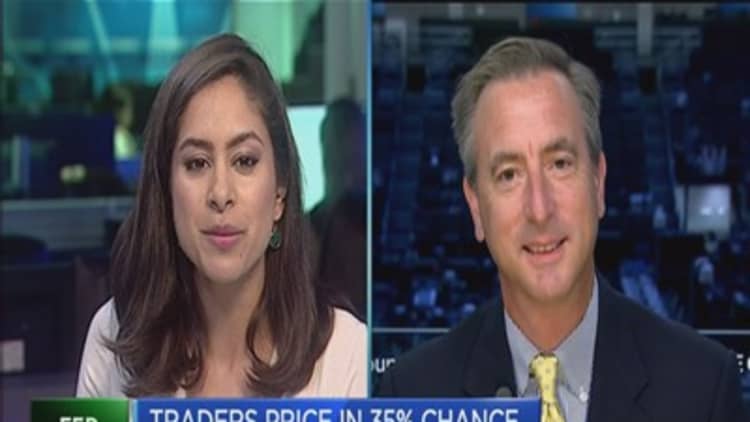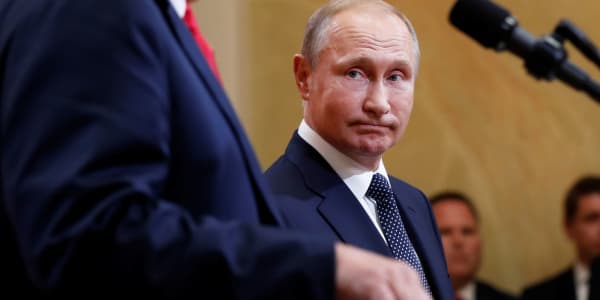Few investors who believe in diversification would have no exposure to global equities, but most investors have no problem having zero exposure to international bonds. Does that make sense?
Especially in a period of time when the Federal Reserve is expected to raise rates and U.S. bond prices decline in value, there is a case to be made for adding exposure to global bonds. Recent performance from global bonds has not been great—and the emerging markets currency free fall can hit local bonds hard—but long-term correlation data between overseas bonds and the U.S. 10-year Treasury does at least merit a look at neglected overseas bonds.
"The international market is changing quickly, and most investors are behind," said Matt Hougan, CEO of ETF.com. "In the bond space, investors are even further behind. Most investors have zero percent exposure to international debt. You wouldn't accept a portfolio with zero percent international equity exposure, so why are you doing it in bonds?"
Read More Welcome to September! Start buying
| Bofa Merrill Lynch bond index | 5-year correlation to US 10-Year Treasury |
|---|---|
| U.S. investment grade | 0.65 |
| Europe investment grade | -0.29 |
| EM investment grade | 0.33 |
| Europe high-yield | -0.39 |
| EM high-yield | -0.26 |
| U.S. high-yield | -0.18 |
(Source: BofA Merrill Lynch, total return in USD—unhedged, as of 7/31/2015)
"Lower correlation, if it holds, would reduce adverse impact on foreign bond prices when rates lift off in the U.S.," said FactSet Research Systems senior analyst Paul Britt.
International bond funds and ETFs allow investors to be tactical with their fixed-income portfolios during a time of divergence between central bank policy and a corresponding increase in global uncertainty around the direction of interest rates.
"A rise in U.S. rates would likely create increased demand for international bonds and international bond ETFs," said Graham Day, director of product development at fund manager Elkhorn Investments. "Historically, international bonds have not always moved in line with U.S. bonds as evidenced by their relatively low correlations to U.S. rates. Today, diverging central bank policies only increase this likelihood, creating pockets of opportunities for investors across international borders."
Read More Don't blame everything on China
Today, diverging central bank policies only increase this likelihood, creating pockets of opportunities for investors across international borders.Graham Daydirector of product development at fund manager Elkhorn Investments
Hougan said the best option for investors to boost bond diversification and reduce overall portfolio risk is Vanguard's Total International Bond Index Fund (BNDX). It's a relatively large global bond ETF, at $3.3 billion in assets, and has a low expense ratio of 0.19 percent.
"BNDX is the fund we like most in this space," said S&P Capital IQ director of ETF and mutual fund research Todd Rosenbluth. "It combines a low expense ratio with a tight bid/ask spread; plus, it's currency hedged, so weakness in the euro or yen doesn't hurt it."
Emerging markets debt funds have seen increased attention because they have offered higher yields than developed market bonds, and fund experts say that should not be lost amid recent volatility.
"I believe that there is a strong case for investing in emerging markets sovereign debt," said Neena Mishra, director of ETF research at Zacks Investment Research. "Many emerging countries now have better fiscal health and lower debt levels than their developed counterparts. Thus, the chances of sovereign default are very low. Further, while the Federal Reserve is getting closer to raising interest rates, central banks in most emerging markets are still cutting rates in order to support growth."
Read More History predicts another volatile week
Rosenbluth pointed to Invesco's actively managed PowerShares Emerging Markets Sovereign Debt Portfolio (PCY), a $2.5 billion fund that has returned 6.65 percent annually over the last five years. "This gives you exposure to bond markets in places like Brazil, Russia and Venezuela," he said. "You take on more risk, but ... risk should be mitigated through your other, diversified holdings," Rosenbluth said.

"Picking international bond exposure is difficult because there are lots of moving parts," FactSet's Britt said. Currency and currency hedging are just one issue that investors need to consider.
BlackRock's iShares J.P. Morgan USD Emerging Markets Bond (EMB) doesn't exactly hedge currency exposure, but instead holds only bonds issued in U.S. dollars by emerging markets issuers. In contrast, Van Eck's Market Vectors Emerging Markets Local Currency Bond (EMLC) holds bonds issued in local currency. EMB may sound less risky because it has no direct currency exposure for U.S. investors, but a local currency that is declining versus the dollar can make it harder for the local borrowers to make their interest payments, turning currency risk into credit risk. EMLC has declined by near-11 percent in the year-to-date period through Aug. 28.
The U.S. dollar issuance favored by EMB will typically make it less volatile, but the local currency approach of EMLC should provide it with lower correlation to the U.S. market. Van Eck's U.S. dollar-denominated EM High Yield Bond ETF (HYEM) is up year-to-date, as are other dollar-denominated EM bond ETFs.
Rosenbluth said the current volatility in emerging markets may serve as another reason for investors to neglect international bond exposure, but it shouldn't. "Despite the volatility in international markets, we think investors should continue to have global fixed-income exposure as a diversifier from U.S. bond products," he said. S&P Capital IQ recommends a currency-hedged product such as BNDX to reduce volatility and gain exposure to countries that have been buying their own debt to stimulate their local economies. For emerging markets debt exposure, S&P Capital IQ favors U.S. dollar-denominated ETFs such as iShares' EMB.
"So far, emerging markets bonds have held up rather well despite turmoil in currency, commodity and equity markets. The two most popular dollar-denominated EM sovereign debt funds, EMB and PCY, have small positive returns year-to-date," Mishra said.
| Fund Name | Year-to-date total return | Expense Ratio | AUM |
|---|---|---|---|
| Vanguard Total International Bond | -0.05% | 0.19% | $3.5B |
| PIMCO Total Return | 0.92% | 0.55% | $2.51B |
| PowerShares Emerging Markets Sovereign Debt | 1.07% | 0.50% | $2.59B |
| Vanguard Emerging Markets Government Bond | 1.40% | 0.34% | $398.36M |
| iShares J.P. Morgan USD Emerging Markets Bond | 0.81% | 0.40% | $5.35B |
| Market Vectors Emerging Markets High Yield Bond | 4.05% | 0.40% | $411.34M |
| WisdomTree Emerging Markets Corporate Bond | -2.39% | 0.60% | $94.09M |
(Source: ETF.com, data through 8/27/2015)
Day said that the current equities decline does not undermine the key reason for pursuing diversified bond exposure: the unprecedented divergence in central bank policy around the globe. China has just devalued its currency, and even though the chances that the Fed hikes rates in September have decreased, traders and Wall Street economists still think there is a fair chance the more hawkish members of the Fed win out sooner than many market pundits now expect.
The recent data on flows into bond funds shows the flight-to-safety mentality, with investors piling into short-term treasuries, but Day said that this data also revealed another reason to become more tactical with bonds on a global basis. In the last major market downturn of 2008, long-term treasury prices performed really well. Now, in the face of rising rates, that correlation is not showing up in bond returns.
In just-released monthly flow data from ETF.com, U.S. government bond funds were the only real "winner" in August, with $6.5 billion in net asset flows (ETFs as a whole only had $2.7 billion in net flows), and the bulk of those dollars landed in shorter-dated, high-quality government debt funds—the kind that offers the safety of Treasurys without too much interest-rate risk, ETF.com reported.
Mishra noted that EM companies (including many energy companies) have borrowed a lot in recent years, and now with China slowing down, rising political risks and prospects of higher interest rates in the U.S., EM asset managers may face sudden demand for redemptions from foreign investors. But, she added, "emerging markets governments are now much better prepared to withstand the sudden outflow of foreign capital, and I believe that chances of sovereign defaults are quite low."
Day said savvy bond investors know that short-term Treasuries won't be enough, nor will a U.S.-only bond universe. "You need to have something more tactical, and we don't have that many tactical managers in the bond space beyond [Jeff] Gundlach and [PIMCO's Total Return Fund] BOND." Day added that the best bond investors right now act more like global macro strategy managers and adding international bond exposure is a component of that approach.
Can you trust Chinese bonds?
Investors buying emerging markets debt ETFs should remember that the underlying securities are rather illiquid, and if many investors head for exits in the event of a selloff, there may be a rout similar to what occurred during the "taper tantrum," when many bond ETFs traded below the estimated value of their underlying bonds. "Investors should be prepared to withstand volatility and stay focused on their longer-term investing goals," Mishra said.
An example of an emerging markets debt market that investors are likely ignoring amid the market correction: the Chinese bond market. And it has held up relatively well even as Chinese stocks have tanked. Mishra is particularly attracted to Global X's China Onshore Bond ETF (CHNB), which has declined 1.5 percent year-to-date and has an expense ratio of 0.50 percent.
"The Chinese domestic bond is now the third largest in the world and is quite liquid," Mishra said. "This market was earlier inaccessible to foreign investors due to government restrictions. China's sovereign credit quality is quite strong, and it has almost $4 trillion in foreign-exchange reserves." Mishra added that the Chinese yuan, being non-convertible, has much lower volatility compared with most other emerging markets currencies.
Chinese 10-year bonds are yielding less than 3.5 percent interest per year, not as low as bonds from slower-growing European or North American nations, but nothing in the recent selling suggests investor panic over bond payments. In fact, Chinese bond yields have fallen through most of 2014 and 2015, according to Trading Economics. Other interest-rate measures like bond spreads have also stayed stable.
How far should an investor wade into international bonds?
Rosenbluth recommends allocating no more than 20 percent of overall bond holdings internationally. Mishra guides investors to 5 percent to 10 percent of fixed holdings in developed market international bonds, and 4 percent to 7 percent in emerging markets, depending on an individual's risk profile.
—By Joe D'Allegro, special to CNBC.com




